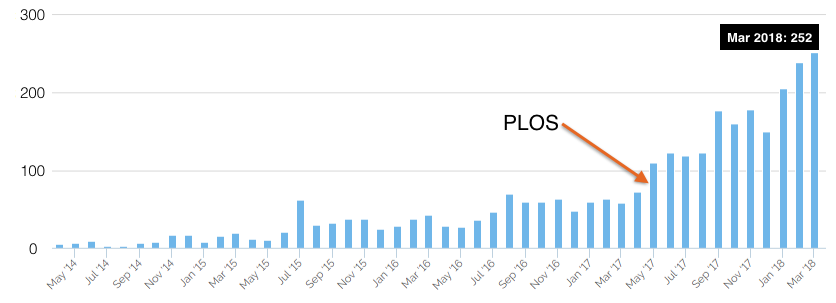Reproducibility and Recognition: One year later
This blog is authored by PLOS staff with contributions by Lenny Teytelman, protocols.io CEO.
For many scientists, there is a common frustration with methods sections of research papers that lack sufficient details, which are necessary to follow up on the work. The mission of protocols.io is to encourage precision and to facilitate the sharing of these details. We’re excited that our partnership with them over the past year is providing yet another catalyst for transforming research communication. Our combined aim is simple: improve the rigor of published research papers by encouraging authors to report precise protocols accompanying their manuscripts on protocols.io.
“In addition to helping the PLOS papers and the scientists reading them, this partnership also had a dramatic impact on the adoption of protocols.io. The new author guidelines at PLOS helped protocols.io to also connect in a similar way to 200 other journals,” says protocols.io CEO Lenny Teytelman. “As a result, the number of scientists creating new protocols every month has more than tripled on protocols.io over the past year.”
Figure Legend: Number of scientists creating new protocols each month on protocols.io
“Partnering with organizations like protocols.io and bioRxiv is a way for PLOS to achieve its Open Science mission in the spirit of collaboration,” says PLOS Executive Editor Veronique Kiermer. “Leveraging the effective platform that protocols.io has developed enables us to take a leap forward in promoting reproducibility.”
Out of the hundreds of protocols accompanying PLOS articles published over the past year, we want to highlight a few great and diverse examples of what scientists have chosen to share via their Materials & Methods sections:
- Functional calibration for trunk and lower limb fixed inertial sensors has videos in each step of the protocol (more about this PLOS ONE paper);
- Digitally Enhanced Recovery: Investigating the Use of Digital Self-Tracking for Monitoring Leisure Time Physical Activity of Cardiovascular Disease (CVD) Patients Undergoing Cardiac Rehabilitation describes the protocol of a field study involving patients, including inclusion/exclusion criteria and step-by-step study details;
- Methods and protocols from Goncalves et al. (2017) for manipulating the diet and the microbiome of Drosophila is an impressive collection of 7 protocols with 80 steps and pages of meticulous guidelines for anyone who wants to repeat and extend the work published in PLOS Biology;
- Ant Genera Identification Using an Ensemble of Convolutional Neural Networks is a computational protocol which the authors of this paper forked from this GigaScience method, a great illustration of how protocols.io users reuse each other’s protocols, add variations and give each other’s credit;
- Methods Accompanying Prior exposure to corticosterone markedly enhances and prolongs the neuroinflammatory response to systemic challenge with LPS — instead of saying “We largely follow manufacturer instructions”, these authors precisely detail the instructions and any modifications from their group that were applied in their paper;
- Fasciola spp. faecal sedimentation protocol for concentration of eggs and DNA isolation, describes in details a new sensitive assay for the rapid detection of this devastating parasite in the field, a tool that the authors suggest should allow surveillance programs in resource-limited settings;
- Detailed protocol for Leptospira isolation from animal samples provides the details of a particularly tricky bacterial isolation protocol central to this PLOS NTDs epidemiology study.
Looking ahead to the rest of 2018: protocols.io continues to broaden its scope to include “all research” instead of simply biomedical and the life sciences. And thanks to our continued partnership authors will soon see an improvement to the platform interface for clinical trials, neuroscience and other fields; a better experience for reporting reagents and equipment; and easier to use templates.
Publish with PLOS and your protocols with protocols.io and let’s keep science open, transparent and reproducible together.

